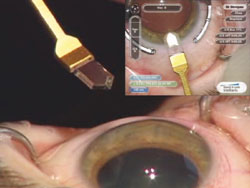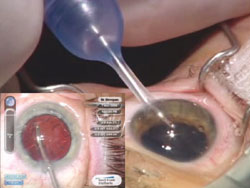Transitioning to microincision cataract surgery
 Uday Devgan |
Cataract surgery has evolved tremendously over the past 2 decades, with a major improvement being a decrease in the incision size.
Injectable IOL technology brought routine incision size to the sub-3-mm range, which reduced the astigmatic effect and helped with incision sealing. Now, with the newer phaco platforms and single-piece acrylic IOLs, sub-2-mm microincision cataract surgery (MICS) is readily accessible.
IOL and instrumentation upgrades
Sometimes, great ideas are not quite ready for prime time, and they need to be temporarily shelved and revived years later. The original Kelman-style phacoemulsification was performed using an approximately 2-mm clear corneal incision. But because there were no foldable or injectable IOLs, the small clear corneal incision was replaced with a scleral tunnel, which could be safely enlarged to accept a rigid IOL. About a decade ago, Amar Agarwal, MS, FRCS, FRCOphth, described his phakonit procedure, which uses a biaxial approach to perform phaco through sub-1-mm incisions. But again, the limitation was the IOL implantation, which required a larger incision.
With the advent of single-piece acrylic IOLs and the wound-assist technique of IOL insertion, we can now use these smaller incisions for phacoemulsification without the need to enlarge. The Tecnis one-piece acrylic IOL (Abbott Medical Optics) and the AcrySof one-piece acrylic IOL (Alcon Laboratories) can both be inserted via incisions of about 2.2 mm, whereas the Akreos MI-60 one-piece acrylic IOL (Bausch & Lomb) can be inserted via an incision of just 1.8 mm. The wound-assist technique involves abutting the injector cartridge against the clear corneal incision, with counter-traction of the eye allowing the incision to function as an extension of the cartridge tip.
 Figure 1. A diamond keratome is used to make a 1.8-mm clear corneal incision for microincision cataract surgery. The smaller incision seals better and induces less astigmatism but requires updating the phaco machine settings to balance the fluidics. The Stellaris (Bausch & Lomb) is used in vacuum mode to provide maximum holding power while minimizing fluid use in the eye. |
 Figure 2. New instrumentation such as this small-gauge irrigation and aspiration probe with updated fluidic settings facilitates the transition to microincision cataract surgery without a significant change in surgical technique. Because this step of surgery requires higher vacuum than nucleus removal, the Stellaris is used in vacuum mode with a maximum of 600 mm Hg. Images: Devgan U |
To make the clear corneal incision for MICS, a diamond or steel keratome is used to create a square entrance into the anterior chamber. The standard capsulorrhexis forceps may not fit through this smaller incision, so an upgrade to newer instruments with thinner arms is advisable. These are available in both Utrata-style and 25-gauge retina-style formats. Because the incision is smaller, care must be taken to float within it and avoid corneal distortion, which can lead to anterior chamber shallowing and an errant capsule tear. This applies while using the phaco probe as well because the diameter of the coaxial phaco tip is a somewhat tight fit through the incision.
Optimizing MICS fluidic parameters
When using smaller incisions, the primary fluidic consideration is the decrease in flow due to the narrowness of the phaco needle and sleeve. Poiseuille’s equation states that the flow of fluid through tubing is proportional to the radius of the tubing to the power of 4. This means that a small change in the tubing radius provides a much larger change in the amount of fluid flow. Remember the analogy of the drinking straw: With a narrow cocktail straw, you would need a large amount of vacuum in your mouth to draw a small amount of fluid. But with a larger drinking straw, just a small amount of vacuum in your mouth produces a good deal of fluid flow.
|
Source: Devgan U |
When first trying sub-2-mm MICS, change the vacuum setting to a higher level, at least 50% above or even double your standard level with sub-3-mm surgery. In order to keep the maximum level of fluidic inflow and inflow pressure, which aids in preventing surge, keep the bottle at the highest level because you can always bring it down should you find the anterior chamber to be over-pressurized. Should you further wish to balance the fluidics, an outflow restrictive tubing can be used. A benefit of MICS is the small amount of fluid that is passed through the eye, with routine cases requiring just a fraction of the fluid of larger bore surgery.
With improved phaco platforms and high-quality single-piece acrylic IOLs, the transition to MICS is relatively easy, with a minimal learning curve for the surgeon and improved results for the patients.

- Uday Devgan, MD, FACS, is in private practice at Devgan Eye Surgery in Los Angeles, Beverly Hills, and Newport Beach, California. Dr. Devgan is Chief of Ophthalmology at Olive View UCLA Medical Center and an Associate Clinical Professor at the Jules Stein Eye Institute at the UCLA School of Medicine. Dr. Devgan can be reached at 11600 Wilshire Blvd., Suite 200, Los Angeles, CA 90025; 800-337-1969; fax: 310-388-3028; e-mail: devgan@gmail.com; Web site: www.DevganEye.com. Dr.Devgan is a consultant to Abbott Medical Optics and Bausch & Lomb, and is a stockholder in Alcon Laboratories and formerly in Advanced Medical Optics.

